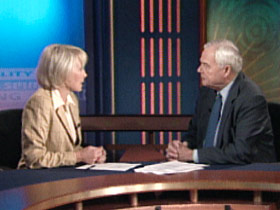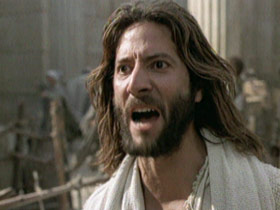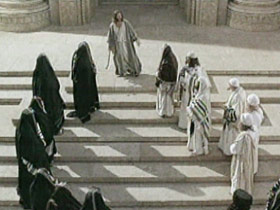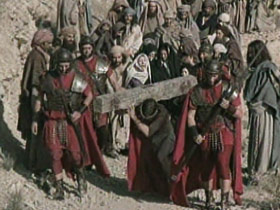In This Episode << SLIDE LEFT TO SEE ADDITIONAL SEGMENTS
THE GOSPEL OF JOHN
BOB ABERNETHY, anchor: Now, the movie version of the gospel according to John — a word-for-word version. Mary Alice Williams is here with a review:

MARY ALICE WILLIAMS: Bob, for the first time in 40 years, the “Greatest Story Ever Told” is being retold in a new round of films with religious themes. The first is THE GOSPEL OF JOHN. Visual Bible International, a faith-based media company, has produced a verbatim adaptation from the GOOD NEWS BIBLE — an accessible translation written in 1966, narrated by Christopher Plummer.
CHRISTOPHER PLUMMER (from THE GOSPEL OF JOHN): In the beginning, The Word already existed.
WILLIAMS: The Gospel of John was written roughly 70 years after the death of Christ and depicts the battle between the emerging church and the religious Jewish hierarchy. Plays about the crucifixion have a long history of inciting anti-Semitic violence, and many scholars believe John’s Gospel is the most anti-Jewish and contentious of the four Gospels of the New Testament.
PLUMMER: There in the temple he found people selling cattle, sheep, and pigeons.
JESUS: Take them out of here. Stop making my father’s house a marketplace.

WILLIAMS: Jesus’ arrogant defiance of the Jewish leadership is thought to have been written specifically to quell the intense debate over what would constitute this new Christian theology and to proclaim once and for all the divinity of Christ.
SAMARITAN WOMAN: I know the Messiah will come.
JESUS: I am He.
WILLIAMS: Jesus’ antagonism toward the Jewish leadership never extends to the Jewish people — his own people. To them he dispenses love and forgiveness.
PHARISEE TEACHER: This woman was caught in the very act of adultery.
JESUS: Whichever one of you has committed no sin may throw the first stone.

WILLIAMS: It is for the people, as proof of his deity, which John tells of Jesus’ extravagant miracles: converting water into wine and a basket of bread and fish to feed thousands; letting the blind see and the dead rise.
JESUS: Lazarus, come out.
WILLIAMS: The producers of THE GOSPEL OF JOHN enlisted a team of historians and theologians to authenticate antiquity, including the worldview of the Jewish people, who were so oppressed by the Romans that their very survival was at stake.
PHARISEE: If we let him go on in this way everyone will believe in him, and the Roman authorities will take action and destroy our temple and our nation.
WILLIAMS: The film’s depiction of Jewish authorities lobbying for crucifixion, the Romans’ preferred method of execution though not sanctioned by Jewish law, is a dark and negative portrayal indeed. But it dodges the controversial theological conclusion that the Jews killed Christ by making it crystal clear, as John’s Gospel does, that Christ’s life and death were part of a divine plan.
PILATE: I find no reason to condemn him.
PHARISEE: We have a law that says he ought to die because he claims to be the son of God.

PILATE: Remember, I have the authority to set you free.
JESUS (to Pilate): You have the authority over me only because it was given to you by God.
WILLIAMS: The film’s depiction of the crucifixion is brutal. No way around it. But [it] is handled with almost cursory dispatch.
JESUS: It is finished.
WILLIAMS: With a rigid fidelity to a Gospel in its entirety, one expects a certain Sunday school blandness. But its commitment to skip the Cecil B. DeMille pageantry and convey the meaning of the story make it work.
ABERNETHY: Mary Alice, did you find any part of the film offensive?
WILLIAMS: In the segment of the Gospel where the crowd is yelling, “Crucify him, kill him!” the editor selected close-up shots of the Jewish leaders — very negative images. On the other hand, one of the directors of the Anti-Defamation League told me he felt it was a fair and responsible treatment of the text.
ABERNETHY: Mary Alice, thank you very much.







